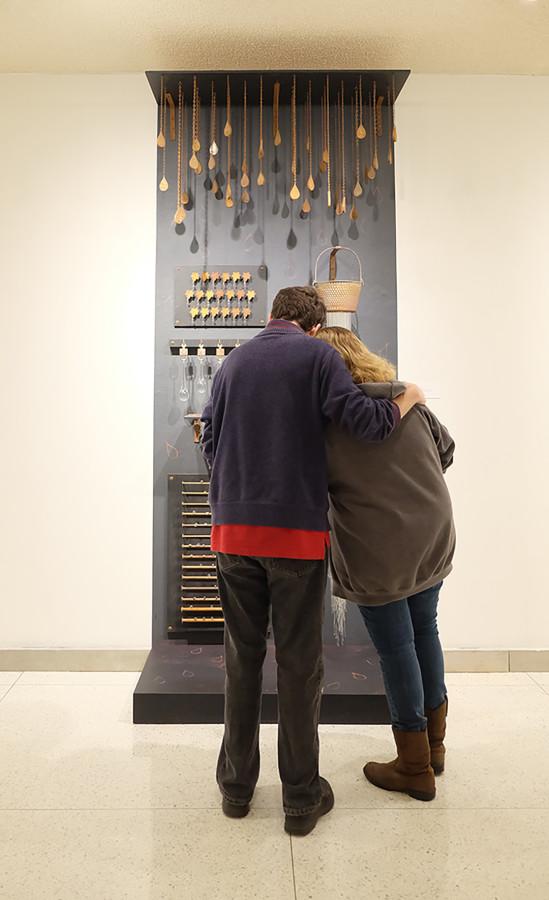Dual exhibits explore the value of water
Kevin Caler, ‘16, and Gabriella Belt, ’17, observe Jennifer Hecker’s “Oh, the Water” mixed media installation. The piece is made with flameworked glass elements, found objects, steel, plywood, paint and red iron oxide.
The opening reception for two new art exhibitions in the Megahan, Bowman and Penelec Galleries was held on Tuesday, Nov. 3 in the Doane Hall of Art at Allegheny College. The show “Water Water Everywhere: Paean to a Vanishing Resource,” is curated by Jennifer Heath and is displayed in the Megahan Gallery. “Water: Elemental, Mutable, Essential,” is co-organized and curated by Heather Brand and Amara Geffen and is exhibited in the Bowman and Penelec Galleries. Both shows examine human relationships with water. The exhibitions will be on display until Nov. 24.
“Water, Water Everywhere” comprises films that are 30-seconds to 30-minutes long, from 45 artists all over the world. The films explore the importance of the planet’s most basic commodity—water—through documentaries and educational artwork. The show is supported in part by Pennsylvania Partners in the Arts, a regional arts nonprofit organization that works with the Pennsylvania Council on the Arts to re-grant funds across Pennsylvania.
The second exhibition, “Water: Elemental, Mutable, Essential,” examines human relationships with water as an essential resource. The artists use water as a subject and a medium to create a space for inquiry, education and reflection.
“The exhibit is beautiful and diverse in terms of artistic voice. It is an important show that deals with something that is essential to our existence and conversely is in peril around the world in terms of the way we treat water, by who controls it and who has access to to it, ” said Steve Prince, professor of art.
“Water is our physical make-up, it is the catalyst for growth, it is the essential ingredient for cleaning—washing, it is a living place for countless animals and organisms, it is the mutable structure that is steam, ice and the water we drink. It is life,” Prince said.
The exhibitions include work done by professional artists and students from introduction to studio art courses.
“Prof. Rich and I brought our students together for a cross-class collaboration as they worked on this assignment. For all of these students this is their first experience showing with professional artists,” said Amara Geffen, professor of art.
Heather Brand, acting gallery director, said the idea was to have environmental issues and local issues that all tied together in the exhibitions.
“We wanted to have something that was semi-sight specific and that tied into the gateway theme,” Brand said. “The most excited response that I’ve had has been people thinking it was all professional artists’ work, where in reality it is half student, half professional.”
Two of the artists in the show, Basia Irland and Besty Damon do work with the local community. Public events will be held later in the year as part of the Year of Meadville, a partnership between Allegheny College and the community.
“This show offers students the opportunity to build a professional portfolio, to create more opportunities for them in the future as they continue on their journey to be an artist or conscious and productive citizen,” Prince said. “But ultimately it teaches the students the importance of community work and collaborative thinking on specific topics that affect us all with the hope of creating change.”










